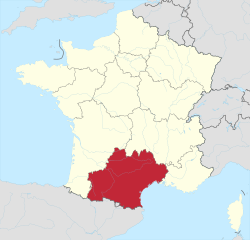| Occitania | |
 | |
| location | |
 | |
| Flag | |
 | |
| Main information | |
| Capital city | Toulouse |
| Currency | euro |
| Surface | 68 706 |
| Population | 5 683 878 |
| Tongue | French |
| religion | Catholicism |
Occitania - the administrative region in the south France. It is the capital Toulouse.

The region as an administrative unit was formally established on January 1, 2016 as a result of the merger of the previously existing regions Languedoc-Roussillon and Midi-Pyrénées.
Until September 30, 2016, the provisional name of Languedoc-Roussillon-Midi-Pyrenees was in force. The name of the region, formally adopted with effect on September 30, 2016 - Occitania - is also the name of the historical land.
Geography
Occitania is located in the southern part of the country, on the shores of the Mediterranean Sea. In its western part lie the rocky Pyrenees, separating the region from Spain. Their highest peak, located in France, is Vignemale, 3928 m above sea level. Aude, Fresquel, Hérault and Orb. This region is also the most densely populated part of Occitania. In the east, the area grows significantly, creating the Central Massif. It is made up of many small mountain ranges. The Cevenne and Montagne Noire are the furthest south, and the Limousin Plateau to the west.
Climate
There is definitely a maritime climate in the region. It is warm, especially in summer, and winters are very mild (temperatures rarely fall below 5 ° C). The annual average here is around 22 ° C, and August is the hottest month. Precipitation is rare and does not exceed 90 mm per year. The highest number is in May and the lowest in July.
History
After the death of Charlemagne, under the treaty of St. Verdun the Frankish state was divided into 3 parts. Occitania, according to the will, fell to Karol Łysy. The region, despite its cultural heritage similar to that of other neighboring areas, retained considerable autonomy. The period from the 9th to the 13th century was a struggle between the Dukes of Aquitaine, Counts of Toulouse and Barcelona for influence in the province. At the end of the disputes, there was a great boom in Occitan literature and art, which significantly developed Western European creativity. With time, the development was stopped by the French monarchs, who eventually took over these areas. In 1539, King Francis I of Wales shook the situation in Occitania sharply, imposing French as a mandatory language in administration, reducing the role of Occitan. Despite such measures, the inhabitants had a strong sense of national identity, which did not break down resistance to the French occupiers. In the second half of the sixteenth century, religious fights took place in the country between Catholic groups, known as the whistles, and Protestant groups, known as condei. Nîmes was then an important center of the Huguenots (a strong Protestant group). Unfortunately, after the Edict of Nantes was proclaimed and Catholicism was officially established, many of them left the country, which had an impact on the demographics and economy. In 1789, revolutionary committees during the French Revolution tried to restore the autonomy of certain regions, taking advantage of the mood in the country, which, unfortunately, was bloodily exterminated by the dictatorship of the left-wing Jacobins. The nineteenth century brought great cultural and economic development, which unfortunately slowed down the actions of the First and later World War II. Currently, the region is one of the important centers for the development of tourism and agriculture, and it is home to some of the largest cities in France.
Policy
Economy
The main branch of the economy is agriculture. The region is the second largest agricultural region in France, right behind Aquitaine. There are nearly 78,500 farms in Occitania. The main crops are cereals, oilseeds and fruits (grapevines, oranges). In addition to agriculture, tourism, services, the machine industry, the precision industry, the arms industry, the wood industry and the food industry are thriving here. It is worth noting that in Toulouse there is the seat of the National Space Research Center (CNES), and in the west of Occitania there is a nuclear power plant in the town of Golfech.
Drive
By car
The main access roads to Occitania are the A54, A7, A75, and A20. They all lead from the east or the north and connect around Toulouse or Montpellier. However, in order to get to these roads from Poland, you need to go through Germany, you can also drive through Switzerland. The main cities we should go to are Stuttgart, and then Lyonswhich is 170 km from the borders of Occitania.
By plane
By ship
Cities
Interesting places
Communication
Shopping
Gastronomy
Accommodation
Security
Health
contact
| This is outline article. For now, it includes the article schema and not much else. You can help by supplementing the article with at least basic information, making it useful. |

_banner.jpg/1800px-Languedoc-Roussillon_(orb_river)_banner.jpg)